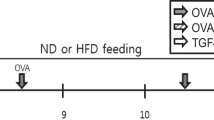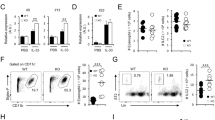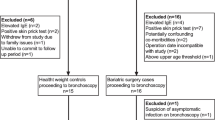Abstract
Obesity is associated with the development of asthma, which is often difficult to control. To understand the immunological pathways that lead to obesity-associated asthma, we fed mice a high-fat diet for 12 weeks, which resulted in obesity and the development of airway hyperreactivity (AHR), a cardinal feature of asthma. This AHR was independent of adaptive immunity, as it occurred in obese Rag1−/− mice, which lack B and T cells, and was dependent on interleukin-17A (IL-17A) and the NLRP3 inflammasome, as it did not develop in obese Il17a−/− or Nlrp3−/− mice. AHR was also associated with the expansion of CCR6+ type 3 innate lymphoid cells (ILCs) producing IL-17A (ILC3 cells) in the lung, which could by themselves mediate AHR when adoptively transferred into Rag2−/−; Il2rg−/− mice treated with recombinant IL-1β. Macrophage-derived IL-1β production was induced by HFD and expanded the number of lung ILC3 cells. Blockade of IL-1β with an IL-1 receptor antagonist abolished obesity-induced AHR and reduced the number of ILC3 cells. As we found ILC3-like cells in the bronchoalveolar lavage fluid of individuals with asthma, we suggest that obesity-associated asthma is facilitated by inflammation mediated by NLRP3, IL-1β and ILC3 cells.
This is a preview of subscription content, access via your institution
Access options
Subscribe to this journal
Receive 12 print issues and online access
$209.00 per year
only $17.42 per issue
Buy this article
- Purchase on Springer Link
- Instant access to full article PDF
Prices may be subject to local taxes which are calculated during checkout






Similar content being viewed by others
References
Flegal, K.M., Carroll, M.D., Kit, B.K. & Ogden, C.L. Prevalence of obesity and trends in the distribution of body mass index among US adults, 1999–2010. J. Am. Med. Assoc. 307, 491–497 (2012).
Osborn, O. & Olefsky, J.M. The cellular and signaling networks linking the immune system and metabolism in disease. Nat. Med. 18, 363–374 (2012).
Wenzel, S.E. Asthma phenotypes: the evolution from clinical to molecular approaches. Nat. Med. 18, 716–725 (2012).
Holguin, F. et al. Obesity and asthma: an association modified by age of asthma onset. J. Allergy Clin. Immunol. 127, 1486–1493.e2 (2011).
Camargo, C.A. Jr., Weiss, S.T., Zhang, S., Willett, W.C. & Speizer, F.E. Prospective study of body mass index, weight change, and risk of adult-onset asthma in women. Arch. Intern. Med. 159, 2582–2588 (1999).
Dixon, A.E. et al. Effects of obesity and bariatric surgery on airway hyperresponsiveness, asthma control, and inflammation. J. Allergy Clin. Immunol. 128, 508–515.e1–2 (2011).
Sutherland, E.R., Lehman, E.B., Teodorescu, M. & Wechsler, M.E. Body mass index and phenotype in subjects with mild-to-moderate persistent asthma. J. Allergy Clin. Immunol. 123, 1328–1334.e1 (2009).
Shore, S.A. Obesity, airway hyperresponsiveness, and inflammation. J. Appl. Physiol. 108, 735–743 (2010).
Farah, C.S. & Salome, C.M. Asthma and obesity: a known association but unknown mechanism. Respirology 17, 412–421 (2012).
Kanneganti, T.D. & Dixit, V.D. Immunological complications of obesity. Nat. Immunol. 13, 707–712 (2012).
Feuerer, M. et al. Lean, but not obese, fat is enriched for a unique population of regulatory T cells that affect metabolic parameters. Nat. Med. 15, 930–939 (2009).
Nishimura, S. et al. CD8+ effector T cells contribute to macrophage recruitment and adipose tissue inflammation in obesity. Nat. Med. 15, 914–920 (2009).
Olefsky, J.M. & Glass, C.K. Macrophages, inflammation, and insulin resistance. Annu. Rev. Physiol. 72, 219–246 (2010).
Scott, H.A., Gibson, P.G., Garg, M.L. & Wood, L.G. Airway inflammation is augmented by obesity and fatty acids in asthma. Eur. Respir. J. 38, 594–602 (2011).
Chen, Y., Dales, R. & Jiang, Y. The association between obesity and asthma is stronger in nonallergic than allergic adults. Chest 130, 890–895 (2006).
Moore, W.C. et al. Identification of asthma phenotypes using cluster analysis in the Severe Asthma Research Program. Am. J. Respir. Crit. Care Med. 181, 315–323 (2010).
Lu, F.L. et al. Increased pulmonary responses to acute ozone exposure in obese db/db mice. Am. J. Physiol. Lung Cell Mol. Physiol. 290, L856–L865 (2006).
Arteaga-Solis, E. et al. Inhibition of leptin regulation of parasympathetic signaling as a cause of extreme body weight-associated asthma. Cell Metab. 17, 35–48 (2013).
Buonocore, S. et al. Innate lymphoid cells drive interleukin-23-dependent innate intestinal pathology. Nature 464, 1371–1375 (2010).
Geremia, A. et al. IL-23–responsive innate lymphoid cells are increased in inflammatory bowel disease. J. Exp. Med. 208, 1127–1133 (2011).
Coccia, M. et al. IL-1β mediates chronic intestinal inflammation by promoting the accumulation of IL-17A secreting innate lymphoid cells and CD4+ TH17 cells. J. Exp. Med. 209, 1595–1609 (2012).
Klose, C.S. et al. A T-bet gradient controls the fate and function of CCR6-RORγt+ innate lymphoid cells. Nature 494, 261–265 (2013).
Sun, Z. et al. Requirement for RORγ in thymocyte survival and lymphoid organ development. Science 288, 2369–2373 (2000).
Sawa, S. et al. RORγt+ innate lymphoid cells regulate intestinal homeostasis by integrating negative signals from the symbiotic microbiota. Nat. Immunol. 12, 320–326 (2011).
Cupedo, T. et al. Human fetal lymphoid tissue-inducer cells are interleukin 17–producing precursors to RORC+ CD127+ natural killer–like cells. Nat. Immunol. 10, 66–74 (2009).
Sanos, S.L. et al. RORγt and commensal microflora are required for the differentiation of mucosal interleukin 22–producing NKp46+ cells. Nat. Immunol. 10, 83–91 (2009).
Luci, C. et al. Influence of the transcription factor RORγt on the development of NKp46+ cell populations in gut and skin. Nat. Immunol. 10, 75–82 (2009).
Chang, Y.-J. et al. Innate lymphoid cells mediate influenza-induced airway hyperreactivity independent of adaptive immunity. Nat. Immunol. 12, 631–638 (2011).
Halim, T.Y., Krauss, R.H., Sun, A.C. & Takei, F. Lung natural helper cells are a critical source of Th2 cell-type cytokines in protease allergen-induced airway inflammation. Immunity 36, 451–463 (2012).
Klein Wolterink, R.G. et al. Pulmonary innate lymphoid cells are major producers of IL-5 and IL-13 in murine models of allergic asthma. Eur. J. Immunol. 42, 1106–1116 (2012).
Spits, H. et al. Innate lymphoid cells—a proposal for uniform nomenclature. Nat. Rev. Immunol. 13, 145–149 (2013).
Winer, S. et al. Normalization of obesity-associated insulin resistance through immunotherapy. Nat. Med. 15, 921–929 (2009).
Ivanov, I.I. et al. Induction of intestinal TH17 cells by segmented filamentous bacteria. Cell 139, 485–498 (2009).
Gaboriau-Routhiau, V. et al. The key role of segmented filamentous bacteria in the coordinated maturation of gut helper T cell responses. Immunity 31, 677–689 (2009).
Veldhoen, M., Hocking, R.J., Atkins, C.J., Locksley, R.M. & Stockinger, B. TGFβ in the context of an inflammatory cytokine milieu supports de novo differentiation of IL-17–producing T cells. Immunity 24, 179–189 (2006).
Lynch, L. et al. Adipose tissue invariant NKT cells protect against diet-induced obesity and metabolic disorder through regulatory cytokine production. Immunity 37, 574–587 (2012).
Wen, H. et al. Fatty acid–induced NLRP3-ASC inflammasome activation interferes with insulin signaling. Nat. Immunol. 12, 408–415 (2011).
Duewell, P. et al. NLRP3 inflammasomes are required for atherogenesis and activated by cholesterol crystals. Nature 464, 1357–1361 (2010).
Larsen, C.M. et al. Interleukin-1-receptor antagonist in type 2 diabetes mellitus. N. Engl. J. Med. 356, 1517–1526 (2007).
Vandanmagsar, B. et al. The NLRP3 inflammasome instigates obesity-induced inflammation and insulin resistance. Nat. Med. 17, 179–188 (2011).
Johnston, R.A. et al. Diet-induced obesity causes innate airway hyperresponsiveness to methacholine and enhances ozone-induced pulmonary inflammation. J. Appl. Physiol. 104, 1727–1735 (2008).
Williams, A.S. et al. Obesity and airway responsiveness: role of TNFR2. Pulm. Pharmacol. Ther. 26, 444–454 (2013).
Johnston, R.A. et al. Allergic airway responses in obese mice. Am. J. Respir. Crit. Care Med. 176, 650–658 (2007).
Calixto, M.C. et al. Obesity enhances eosinophilic inflammation in a murine model of allergic asthma. Br. J. Pharmacol. 159, 617–625 (2010).
Kudo, M. et al. IL-17A produced by αβ T cells drives airway hyper-responsiveness in mice and enhances mouse and human airway smooth muscle contraction. Nat. Med. 18, 547–554 (2012).
McKinley, L. et al. TH17 cells mediate steroid-resistant airway inflammation and airway hyperresponsiveness in mice. J. Immunol. 181, 4089–4097 (2008).
Wakashin, H. et al. IL-23 and TH17 cells enhance TH2-cell–mediated eosinophilic airway inflammation in mice. Am. J. Respir. Crit. Care Med. 178, 1023–1032 (2008).
Lajoie, S. et al. Complement-mediated regulation of the IL-17A axis is a central genetic determinant of the severity of experimental allergic asthma. Nat. Immunol. 11, 928–935 (2010).
Murdoch, J.R. & Lloyd, C.M. Resolution of allergic airway inflammation and airway hyperreactivity is mediated by IL-17–producing γδ T cells. Am. J. Respir. Crit. Care Med. 182, 464–476 (2010).
Naik, S. et al. Compartmentalized control of skin immunity by resident commensals. Science 337, 1115–1119 (2012).
Gross, O., Thomas, C.J., Guarda, G. & Tschopp, J. The inflammasome: an integrated view. Immunol. Rev. 243, 136–151 (2011).
Eisenbarth, S.C., Colegio, O.R., O'Connor, W., Sutterwala, F.S. & Flavell, R.A. Crucial role for the Nalp3 inflammasome in the immunostimulatory properties of aluminium adjuvants. Nature 453, 1122–1126 (2008).
Besnard, A.G. et al. NLRP3 inflammasome is required in murine asthma in the absence of aluminum adjuvant. Allergy 66, 1047–1057 (2011).
Allen, I.C. et al. Analysis of NLRP3 in the development of allergic airway disease in mice. J. Immunol. 188, 2884–2893 (2012).
Kool, M. et al. An unexpected role for uric acid as an inducer of T helper 2 cell immunity to inhaled antigens and inflammatory mediator of allergic asthma. Immunity 34, 527–540 (2011).
Marichal, T. et al. DNA released from dying host cells mediates aluminum adjuvant activity. Nat. Med. 17, 996–1002 (2011).
Crellin, N.K. et al. Regulation of cytokine secretion in human CD127+ LTi-like innate lymphoid cells by Toll-like receptor 2. Immunity 33, 752–764 (2010).
Winer, S. et al. Obesity predisposes to TH17 bias. Eur. J. Immunol. 39, 2629–2635 (2009).
Fantuzzi, G. Adipose tissue, adipokines and inflammation. J. Allergy Clin. Immunol. 115, 911–919, quiz 920 (2005).
Kim, H.Y., DeKruyff, R.H. & Umetsu, D.T. The many paths to asthma: phenotype shaped by innate and adaptive immunity. Nat. Immunol. 11, 577–584 (2010).
Nakae, S. et al. Antigen-specific T cell sensitization is impaired in IL-17–deficient mice, causing suppression of allergic cellular and humoral responses. Immunity 17, 375–387 (2002).
Sutterwala, F.S. et al. Critical role for NALP3/CIAS1/Cryopyrin in innate and adaptive immunity through its regulation of caspase-1. Immunity 24, 317–327 (2006).
McKenzie, G.J., Fallon, P.G., Emson, C.L., Grencis, R.K. & McKenzie, A.N. Simultaneous disruption of interleukin (IL)-4 and IL-13 defines individual roles in T helper cell type 2-mediated responses. J. Exp. Med. 189, 1565–1572 (1999).
Akbari, O. et al. Essential role of NKT cells producing IL-4 and IL-13 in the development of allergen-induced airway hyperreactivity. Nat. Med. 9, 582–588 (2003).
Acknowledgements
We thank the National Institutes of Health Tetramer Facility, Emory University, Atlanta, Georgia, for providing CD1d tetramers. This work was supported by grants RO1AI068085, RO1HL62348 and ES013307 from the US National Institutes of Health and with funds from The D. and D. Bunning Food Allergy Project.
Author information
Authors and Affiliations
Contributions
H.Y.K. designed the study, did the experiments, analyzed the data and wrote the manuscript; H.J.L. did SFB experiments and analyzed the data; Y.-J.C. helped with the experiments involving human cells; M.P. did experiments; S.A.S. analyzed the data and edited the manuscript; K.A.F. and Y.I. provided Nlrp3−/− and Il17a−/− mice; E.I., K.B. and J.F. provided human BAL fluid samples and information; R.H.D. provided reagent support and edited the manuscript; and D.T.U. designed the study and wrote the manuscript.
Corresponding author
Ethics declarations
Competing interests
The authors declare no competing financial interests.
Supplementary information
Supplementary Text and Figures
Supplementary Figures 1–7 and Supplementary Table 1 (PDF 2506 kb)
Rights and permissions
About this article
Cite this article
Kim, H., Lee, H., Chang, YJ. et al. Interleukin-17–producing innate lymphoid cells and the NLRP3 inflammasome facilitate obesity-associated airway hyperreactivity. Nat Med 20, 54–61 (2014). https://doi.org/10.1038/nm.3423
Received:
Accepted:
Published:
Issue Date:
DOI: https://doi.org/10.1038/nm.3423
This article is cited by
-
Physiological and immunological barriers in the lung
Seminars in Immunopathology (2024)
-
Inhibition of fatty acid synthase protects obese mice from acute lung injury via ameliorating lung endothelial dysfunction
Respiratory Research (2023)
-
Leptin/obR signaling exacerbates obesity-related neutrophilic airway inflammation through inflammatory M1 macrophages
Molecular Medicine (2023)
-
Group 3 innate lymphoid cells secret neutrophil chemoattractants and are insensitive to glucocorticoid via aberrant GR phosphorylation
Respiratory Research (2023)
-
Characterization and inhibition of inflammasome responses in severe and non-severe asthma
Respiratory Research (2023)



